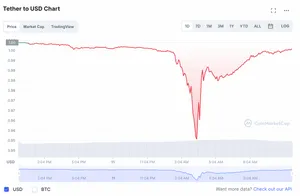Deltec is a well-known bank in the cryptocurrency world, mostly for its ties to Tether and to FTX. In July 2023, US authorities seized tens of millions from Deltec accounts in connection to a cryptocurrency money laundering investigation. It's not clear if that was the same investigation.
Crypto scam money launderers charged for laundering more than $73 million through Deltec
Someone accidentally burns $1.36 million Tether
Most experienced crypto users have adopted the habit of sending small test transactions before transferring large amounts of tokens, to first check that they're using the correct address. Oddly, this person did so in this case, but then went right ahead and transferred the remaining tokens to the erroneous address.
The person may have lucked out that they were using a centralized stablecoin like Tether, whose operators hold a substantial amount of control over freezing, destroying, and creating new Tethers — and could feasibly replace the burned tokens.
Myanmar-based romance scam operation pulls in $100 million in less than two years
Many of the workers for the romance scam group are themselves victims of human trafficking. The operation is based in a "compound" near Myanmar's border with Thailand, and researchers estimate that thousands of trafficked workers operate the scam from the "self-contained city".
The scam may put more pressure on Tether, whose role in human trafficking and high-volume romance scam operations has been scrutinized more heavily in recent months and years. Tether has frozen some assets belonging to romance scammers in the past, but remains the token of choice for many of these groups.
- "$100mn in crypto payments traced to Myanmar-based 'scammers'", Financial Times [archive]
Tether mints itself a $1 billion Christmas present
On December 25, Tether minted 1 billion of its USDT dollar-pegged stablecoin. CEO Paolo Ardoino announced on Twitter that the mint was an "authorized but not issued transaction, meaning that this amount will be used as inventory for next period issuance requests and chain swaps". This seems to be a recent trend for Tether, as similar language was used for a $1 billion mint in September.
The activity has raised more questions around where the real money backing Tether is coming from, and if it even exists at all. Some have argued that these recent Tether mints are being used to artificially inflate the price of Bitcoin, which has been on an upward trend since mid-October.
Tether, which boasts a market cap of more than $90 billion, has never been audited, and has lied about its backing in the past.
DOJ cracks down on $225 million crypto romance scam
According to Tether, they "voluntarily fr[oze] approximately 225 million in USDT tokens" in connection to the investigation.
Some romance scammers hoping to lure victims into sending them cryptocurrencies are themselves victims of human trafficking operations, where they are held victim and forced to send such messages.
Phisher briefly snags $20 million before it's frozen by Tether
Someone intending to transfer Tether stablecoins amounting to $20 million apparently didn't think it was important to double-check the address, and fell for such an attack.
However, only 51 minutes after the theft, the victim had managed to get Tether to add the thief's address to its blacklist, freezing the assets and thwarting the attack. The rapidity of the freeze led various people to question who the victim might be who could get Tether to intervene so quickly.
- "Tether Freezes $20 Million Linked To Phishing Scammer", CryptoPotato
WSJ alleges Tether, Bitfinex, and related companies used falsified documents to obtain banking
Among other allegations, the WSJ outlined how Tether was repeatedly denied accounts at New York's Signature Bank, and so ultimately got an executive at an aviation fuel broker called AML Global to open an account that appeared to be used to fraudulently process transactions on behalf of Tether and Bitfinex.
Tether is the largest stablecoin in circulation, though its entire existence has been marred by questions around its legitimacy and the status of its claimed reserves.
Tether loses peg, drops below $0.95
Tether began to recover somewhat as the day progressed, gradually returning to above $0.99. However, the de-peg has clearly shaken the cryptocurrency ecosystem. The heavy reliance on Tether means that a substantial or protracted loss of its peg would be devastating, and the open secret that Tether does not have the backing assets it once claimed has intensified fears about a possible run on Tether.



